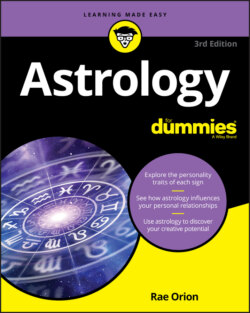Читать книгу Astrology For Dummies - Rae Orion - Страница 44
Looking at Early Astrology
ОглавлениеAncient peoples watched the sky as we do not: with attention. About 34,000 years ago, Stone Age observers recorded the cycle of the Moon on pieces of bone and antler. Some 17,000 years later, their descendants painted the bull of Taurus and the star cluster of the Pleaides — there can be no mistaking those identifications — on the walls of a cave in what is now France. In China, astrological activity dates back to the fifth millennium BCE. The most concentrated astronomical activity in the western world was in Mesopotamia. By 3,000 BCE, Babylonian stargazers had mapped the constellations, determined the length of the lunar month (a little more than twenty-nine and a half days), charted the cycle of Venus, marked the appearance of comets, meteors, rainbows, storms, and cloud formations, and sought correlations between celestial goings-on and events here on Earth. During the second millennium BCE, they recorded their findings on dozens of clay tablets collectively known as the Enuma Anu Enlil, which translates as “When Anu and Enlil” and refers to the sky god Anu and his son Enlil, lord of air and weather. This was not astrology as we know it. It was not personality analysis in any sense. Rather, it was a collection of useful omens. These are typical:
When Jupiter goes out from behind the Moon, there will be hostility in the land.
When the fiery light of Venus illuminates the breast of Scorpio, then rain and floods will ravage the land.
When Mercury is visible in Kislew, there will be robbers in the land.
When Mercury approaches Spica, the crops of the land will prosper, the cattle will be numerous in the fields, the king will grow strong. Sesame and dates will prosper.
These pronouncements were messages from the gods. They were political or weather-related, focused on war and peace, floods and famine. Vague and often portentous, they were heralds of catastrophe or — less often — prosperity. But they were not personal (unless you were the king).
By the middle of the first millennium BCE, Western astronomers and astrologers — there was no difference — had settled upon the zodiac as we know it, whittling it down from 18 constellations to 12. Equally important, they had identified the ecliptic, the path followed by the Sun as it rolls across the sky, and divided it into 12 sections, each 30 degrees long. This advance allowed for the creation of the signs (as distinct from the constellations), each one equal in duration, length, and value. Thus the seeds of modern astrology were strewn in ancient Babylonia. From there, they wafted into Egypt, into Greece, and throughout Mesopotamia all the way down to Chaldea, a small area in the southeast where observers recorded eclipses and other celestial phenomena. In time, as Chaldea was absorbed into the larger, more powerful Babylonia, the word “Chaldean” gradually came to mean one thing: astrologer.
